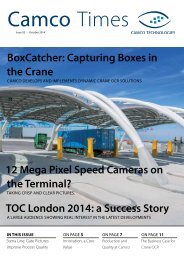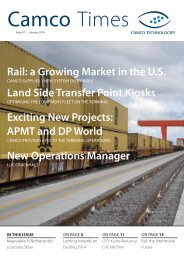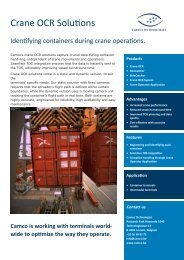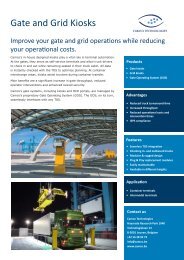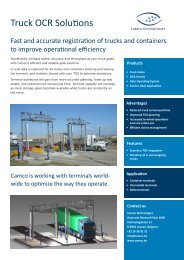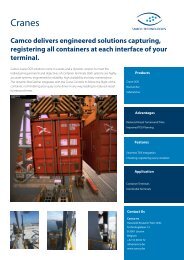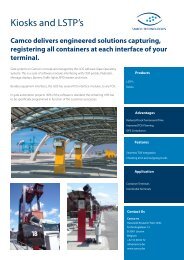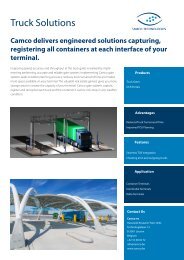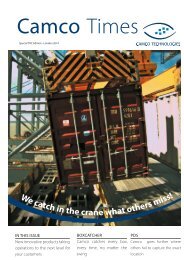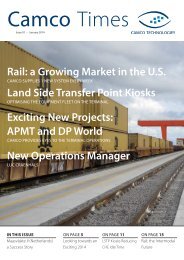Camco Times 2
BoxCatcher in depth. The brand new 12MPx camera sees everything.
BoxCatcher in depth. The brand new 12MPx camera sees everything.
You also want an ePaper? Increase the reach of your titles
YUMPU automatically turns print PDFs into web optimized ePapers that Google loves.
<strong>Camco</strong> <strong>Times</strong><br />
Issue 02 – October 2014<br />
BoxCatcher: Capturing Boxes in<br />
the Crane<br />
CAMCO DEVELOPS AND IMPLEMENTS DYNAMIC CRANE OCR SOLUTIONS<br />
12 Mega Pixel Speed Cameras on<br />
the Terminal<br />
TAKING CRISP AND CLEAR PICTURES.<br />
TOC London 2014: a Success Story<br />
A LARGE AUDIENCE SHOWING REAL INTEREST IN THE LATEST DEVELOPMENTS<br />
IN THIS ISSUE<br />
Stena Line: Gate Pictures<br />
improve Process Quality<br />
ON PAGE 5<br />
Innovation, a Core<br />
Value<br />
ON PAGE 7<br />
Production and<br />
Quality at <strong>Camco</strong><br />
ON PAGE 11<br />
The Business Case for<br />
Crane OCR
<strong>Camco</strong> <strong>Times</strong><br />
2 <strong>Camco</strong> <strong>Times</strong> 02/2014
<strong>Camco</strong> <strong>Times</strong><br />
colophon<br />
Editor<br />
Jan Bossens<br />
Contributing editors<br />
Nico Berx<br />
Designer<br />
Nico Berx<br />
Manager<br />
Anton Bernaerd<br />
Jef De Geeter<br />
Patrick Lemli<br />
Business Development<br />
Anton Bernaerd<br />
Special thanks to<br />
Ralph Bosveld<br />
In this issue<br />
5 Innovation, a Core Value for <strong>Camco</strong><br />
6 Stena Line: Gate Pictures Contribute to Managing Quality<br />
7 Production at <strong>Camco</strong><br />
9 BoxCatcher: Dynamic Crane OCR Systems<br />
11 The Business Case for Crane OCR<br />
12 12 Mega Pixel Speed Cameras on the Terminal<br />
13 TOC London 2014<br />
14 Safety on-site: the Prime Concern<br />
15 Meet our Customers<br />
Contact<br />
<strong>Camco</strong> <strong>Times</strong> is a publication<br />
of <strong>Camco</strong> nv. If you have any<br />
questions about one of our<br />
publications, please contact us<br />
at +32 16 38 92 72 or e-mail<br />
us at info@<strong>Camco</strong>.be<br />
www.<strong>Camco</strong>.be<br />
<strong>Camco</strong> Technologies NV<br />
Researchpark Haasrode 1040<br />
Technologielaan 13<br />
B-3001 Leuven<br />
Belgium<br />
ABOUT <strong>Camco</strong> Technologies<br />
<strong>Camco</strong> Technologies is the world-leading vendor of Visual-Assisted Automation systems and solutions<br />
for all types of maritime and railway terminals around the world. Its innovative, high-performing,<br />
powerful and extremely modular OCR (Optical Character Recognition), pedestal and Gate Operating<br />
System (GOS) software solutions allow terminals to increase radically their gate, rail, crane and yard<br />
operations, productivity and safety.<br />
Pictures: <strong>Camco</strong>, Studio<br />
Aksento (cover pages and<br />
page 2)<br />
<strong>Camco</strong> contributes to the overall productivity, performance and safety on container and intermodal<br />
terminals delivering high-end Visual Automated Systems. For each step in the handling process of containers,<br />
customers benefit from <strong>Camco</strong> Technologies.<br />
• OCR portals recognize incoming and outgoing boxes with the highest accuracy rates<br />
• Crane OCR systems read all container data<br />
• Land Side Transfer Points kiosks synchronise the moves between trucks and (automated)<br />
stacking cranes.<br />
<strong>Camco</strong> accurately registers containers entering or exiting the terminal by any means<br />
of transport: Truck, Train or Vessel, enabling Terminal Operating Systems (TOS) to make<br />
the right planning decisions, reducing unproductive moves and idle time on the terminal.<br />
<strong>Camco</strong> is currently the preferred partner of many major global terminal operators.<br />
<strong>Camco</strong> delivers engineered customised systems based on available and proven technology, connected<br />
to own software systems (GOS), interfacing with all TOS and automation systems, to deliver<br />
tailor-made solutions answering and exceeding the unique needs and requirements of each terminal.<br />
For over 15 years, <strong>Camco</strong> has been contributing to a safe and performing working environment, greatly<br />
improving the information flow and accuracy, the basis for efficient and effective terminal operations.<br />
<strong>Camco</strong> <strong>Times</strong> 02/2014 3
<strong>Camco</strong> <strong>Times</strong><br />
<strong>Camco</strong> offices in Leuven, Belgium<br />
4 <strong>Camco</strong> <strong>Times</strong> 02/2014
<strong>Camco</strong> <strong>Times</strong><br />
Innovation, a Core Value<br />
for <strong>Camco</strong><br />
Thank you all for your positive reactions on our first edition of the <strong>Camco</strong> <strong>Times</strong>. We appreciated your feedback and response.<br />
Innovation is a key value at <strong>Camco</strong>! We are spending yearly a considerable amount of resources on developing new solutions and optimising<br />
the existing products to continue enabling our customers to achieve ever better results. In this edition we focus on the following areas:<br />
• Crane OCR<br />
• 12 Mega Pixel Camera<br />
• Interfaces to TOS systems.<br />
Innovation does mean more than technology for <strong>Camco</strong>!<br />
We constantly strive to improve the overall quality of our internal processes and procedures, on all levels, from sales to design, production,<br />
quality insurance, project implementation, delivery to after-sales support.<br />
Daivy, managing the production department, shares his story and gives insight in how production, quality insurance and delivery<br />
is organised.<br />
Innovation also means safety! Safety gets an ever more important place in our work. <strong>Camco</strong> complies with the stringent SCC (Safety<br />
Certificate Contractor) rules and regulations. Further in the second edition of the <strong>Camco</strong> <strong>Times</strong> we will highlight what we are doing with<br />
respect to occupational health and safety and the benefits it brings.<br />
Innovation means making the service and maintenance to our customers better, faster and more efficient. <strong>Camco</strong> is assessing its maintenance<br />
and support services to improve the customer experience!<br />
At <strong>Camco</strong> we have been working hard on our ongoing project implementations and are delighted to announce that we concluded new<br />
contracts to implement our solutions:<br />
APMT Lazaro Cardenas in Mexico<br />
KAP in the Kingdom of Saudi-Arabia<br />
At London Gateway, <strong>Camco</strong> starts implementing BoxCatcher Crane OCR systems on crane 2 to 8 after a successful pilot<br />
For every terminal, of every size <strong>Camco</strong> has the right solution and contributes to the overall efficiency, safety and security of terminals. Read<br />
the inspiring interview with Ralph Bosveld from Stena Line telling you how Stena benefits from the <strong>Camco</strong>’s know-how and expertise.<br />
Looking back at the successful TOC 2014 in London, we thank you for your continuous support.<br />
Best regards and enjoy reading our second edition of the <strong>Camco</strong> <strong>Times</strong>.<br />
Jan Bossens<br />
CEO<br />
<strong>Camco</strong> <strong>Times</strong> 02/2014 5
<strong>Camco</strong> <strong>Times</strong><br />
High Quality Pictures<br />
Essential to Manage<br />
Service Quality<br />
The Stena Line Terminal in Europoort (Rotterdam Netherlands) is using the <strong>Camco</strong> truck gate system since 2008 to register every vehicle entering<br />
and leaving the terminal. Stena operates a RoRo terminal, handling around 250 trucks per day (import and export) on a direct line to<br />
Harwich in the United Kingdom. Ralph Bosveld manages the Stena terminal. Ralph explains:” getting the terminal up and running, back in 2008,<br />
was a challenging task, since we only had 3 months to be ready for the first vessel. Together with our suppliers we did the job!”<br />
During the implementation, Ralph was responsible for:<br />
• Design of the layout<br />
• Hiring contractors for building the infrastructure<br />
• Hiring staff<br />
• Developing, constructing and implementing the gates<br />
After a selection process, <strong>Camco</strong> was contracted to deliver and implement the gate systems, one lane in, and one lane<br />
out. Looking back at the project Ralph thinks back about the importance of defining good, performing and optimised processes. <strong>Camco</strong> contributed<br />
a great deal in the definition of the processes. The processes match the core values of Stena: “Customer and Service Oriented”.<br />
For Stena the major advantage of the <strong>Camco</strong> gates is the fact that the high resolution pictures are used in case of claims. The Stena service<br />
between Rotterdam and Harwich is to be seen as a closed loop. In Rotterdam Stena handles the vessels, while an independent stevedore,<br />
working for Stena handles the vessels in Harwich. Both terminals use the <strong>Camco</strong> gate system. Anything that happens between the camera at<br />
the Rotterdam lane-in and the Harwich lane-out is the responsibility of Stena, and the pictures show the condition of the trailers at each registration<br />
point.<br />
Quality is of the utmost important for Stena, damages are prevented as much as possible. Should, nevertheless, damage occur, then the picture<br />
are actively used to determine the damage.<br />
Since its implementation in 2008, the system continues perfectly. Other than the regular maintenance, nor major issues occurred. Maintenance<br />
is provided pro actively by the <strong>Camco</strong> maintenance and support team on an annual basis.<br />
The canopy greatly contributes to conserve the hardware in the harsh marine circumstances. Ralph believes that quality of the pictures benefit<br />
from the canopy because optimal lighting conditions, in all seasons, are created.<br />
In May, the new Stena terminal in Hoek-Van-Holland opened. This terminal has the same setup as the Europoort terminal, which served as a<br />
blueprint. The same gate configuration was implemented, since the system is reliable and proven. <strong>Camco</strong> is happy and grateful to serve Ralph<br />
and Stena Line!<br />
Stena Line Fact Sheet<br />
Type of Operations: RoRo<br />
Surface: 15ha<br />
Capacity: 500 moves per day.<br />
Quay Length: 400m<br />
Equipment: tugmasters<br />
Gate management (land)<br />
<strong>Camco</strong>: 2 truck gates<br />
Ralph in front of his Gate System<br />
6 <strong>Camco</strong> <strong>Times</strong> 02/2014
<strong>Camco</strong> <strong>Times</strong><br />
Producing Visual<br />
Automation Solutions<br />
subsystems are allocated for production, project assemblies or delivery<br />
to customers.<br />
Accuracy, pleasant working conditions, good lighting and anti-static<br />
protection measures are a must for accurate production meeting the<br />
highest quality standards. Quality assurance is an important element<br />
of the production process. The quality checks focus on: functionality,<br />
stability and burn-in. Burn-in tests are procedures to test components,<br />
assemblies and systems under circumstances harder then a regular<br />
production environment.<br />
Integral Quality Control<br />
From Design, over Purchasing to Assembly<br />
Daivy (left) explaining a<br />
production technique.<br />
Delivering tested and quality approved systems start with buying,<br />
receiving, testing and storing the right components and subsystems.<br />
Daivy De Swert manages the production and the warehouse<br />
at <strong>Camco</strong>. Daivy brings extensive production experience to <strong>Camco</strong>’s<br />
customer. After graduating as electromechanical engineer, Daivy<br />
started his career 9 years ago as production engineer at a technology<br />
company, where he grew to become the production manager.<br />
The production staff lives and breathes quality. Daivy:” Integral quality<br />
assurance, from reception to delivery is the best guarantee for <strong>Camco</strong><br />
customers.” In addition to his regular production tasks, Daivy focuses<br />
on administration, the maintenance of the ERP (Enterprise Resource<br />
Planning) system and contributes to Research and Development<br />
producing prototypes. The optimisation of production processes to<br />
provide ever better systems to customers is a main objective and<br />
driver for <strong>Camco</strong>.<br />
At the beginning of 2014 he joined <strong>Camco</strong> to optimise the supply<br />
chain, the production process and further develop the testing and<br />
quality assurance.<br />
The production and assembly starts with the reception of the deliveries<br />
from carefully selected suppliers. Before storing components, the<br />
main components are tested, registered and labelled. After approval,<br />
components are stored. From the warehouse, components and<br />
Ticket Printers<br />
Lined up<br />
Quality Inspection<br />
Burn-in test of assemblies<br />
<strong>Camco</strong> <strong>Times</strong> 02/2014 7
<strong>Camco</strong> <strong>Times</strong><br />
BoxCatcher: catching each box, every time. No constraints.<br />
Vessel turnaround time is an essential element in most contracts between shipping lines and terminals. Improving speed<br />
and accuracy in every step of the process contributes to reducing the turnaround time. BoxCatcher contributes to the<br />
speed of the vessel loading and discharging process by automating the tally process, including the reading of IMO labels<br />
and seal presence. Curious to find out how <strong>Camco</strong> contributes to impoving speed and accuracy on your terminal Contact<br />
us to explore together how your terminal and your customers will benefit from <strong>Camco</strong>’s expertise.<br />
8 <strong>Camco</strong> <strong>Times</strong> 02/2014<br />
BoxCatcher capturing all containers
<strong>Camco</strong> <strong>Times</strong><br />
BoxCatcher: identifying<br />
every box at maximum<br />
quay crane performance.<br />
Answering tough and challenging requirements: reading every box during vessel operations without delays.<br />
<strong>Camco</strong> developed a unique and innovative solution that will revolutionize the crane OCR world: millimeter-resolution cameras are fitted on<br />
a linear-table fitted on the legs or beams of the quay cranes. The cameras follow the flight path of the containers. There are no fixed patterns:<br />
the quay crane driver determines the ideal path, the BoxCatcher system follows and takes high quality pictures at exactly the right time. OCR<br />
and image analysis follow automatically.<br />
Not constraining the quay crane operator in any way<br />
The quay crane driver operates the crane in the most optimal way, taking into account the operational conditions: container weight and<br />
balance, position of the container, tide, wind, safety rules, lashing sequence... Having a BoxCatcher system installed does not require the operator<br />
to follow a constrained path. Whatever the travelling speed of the container under the spreader, the BoxCatcher is capable of taking sharp<br />
images in any condition and at any speed of every side.<br />
Perfect triggering: sharp and readable images, with or<br />
without swing<br />
For the triggering <strong>Camco</strong> partly uses the information of the PLC<br />
controlling the crane. The PLC provides the theoretical position of<br />
the spreader, but does not show the swing of the spreader and the<br />
container.<br />
The swing is the horizontal movement of the box, caused by<br />
gravity when accelerating and/or decelerating the gantry. <strong>Camco</strong><br />
has developed an inventive and innovative solution that compensates<br />
for this swing allowing the continuous acquisition of images at<br />
exactly the right time. It does not matter the type of move, single 20”,<br />
40” or a tandem 45…<br />
Containers in Tandem: pictured and captured<br />
A major leap forward to terminal operators and shipping lines<br />
High accuracy, not reducing the crane speeds or constraining the quay crane driver in any way contributes greatly to the efficient loading<br />
and discharging of containers. Add the increased accuracy and safety registering physical container data, and the advantages are obvious. The<br />
BoxCatcher takes over the job of the tally men. It reads the container number, ISO code, door direction, IMDG classification numbers and the<br />
seal presence. The <strong>Camco</strong> Crane OCR System (COS) interfaces with all the major TOS and transfers the data for checking and further operational<br />
use.<br />
<strong>Camco</strong> <strong>Times</strong> 02/2014 9
<strong>Camco</strong> <strong>Times</strong><br />
Talking STS cranes<br />
A ship-to-shore crane or Quay Crane (STS or QC) is a giant machine<br />
weighing around 2000 tonnes, running on rails with a pitch of<br />
approximately 30 meters (depending on the type). The STS or QC<br />
discharges containers form or loads containers on container vessels.<br />
QC’s are about 90 meters high, an outreach of 72 meters, calculated<br />
from the front rail, and a back reach of around 25m. The STS can safely<br />
lift 65 to 80 tonnes depending on configuration, and are technically<br />
capable delivering well over 50 moves per hour. This means that almost<br />
every minute a container can be handled.<br />
Reliability: the main design criterium<br />
The mechanical design and testing of the system took several years!<br />
The requirements to meet were challenging and the working conditions<br />
on a quay crane are harsh and aggressive: wind, rain, hail, snow, salt etc.<br />
Reliability goes way beyond the product features and characteristics.<br />
Designing the system, <strong>Camco</strong> required the system to produce repeatable<br />
and high quality results: container numbers, ISO codes, IMDG codes!<br />
<strong>Camco</strong> met all of the design requirements. <strong>Camco</strong> commits to 5 years<br />
warranty of the mechanical rail system.<br />
<strong>Camco</strong>’s proven solution takes accurate pictures under all circumstances<br />
Installation in 2 days time, safe and easy maintenance<br />
<strong>Camco</strong> engineers fit the pre-assembled system in one day. The electrical wiring is done on the second day, and the system is fully operational on<br />
day 3. The downtime of the quay crane is very limited.<br />
For the maintenance of the system, the camera is returned to its lowest position, the home position, where the camera can be accessed from the<br />
portal beams or platform. The time available during shift changes is usually sufficient to maintain the system. Maintenance on other systems in the<br />
market requires far more valuable Quay Crane time (operational down time) and specialised equipment such as cherry pickers, high-boom trucks<br />
and platforms.<br />
IMDG LABELS: presence or classification<br />
Detecting the presence of an IMDG label does not really contribute to the safety on the terminal or compliance with<br />
rules in place regarding IMO and IMDG handling.<br />
What matters is the classification, indicated on the label, the Dangerous Goods number. This is printed on the label<br />
and is 10 to 15mm wide by 22mm high, actually 4 times smaller than a container number. Reading the actual classification<br />
requires 12 mega pixel cameras, the right positioning of the cameras and triggering mechanisms to actuate the<br />
shutter at the right time. Based on the classification, segregation rules will be applied to avoid any potentially dangerous<br />
situation on the terminal. Safe planning contributes to safety for personnel respect for the environment.<br />
10 <strong>Camco</strong> <strong>Times</strong> 02/2014
<strong>Camco</strong> <strong>Times</strong><br />
The business case for<br />
Crane OCR<br />
With an introduction of an OCR application in cranes it’s important to have a<br />
good view on the business case or the ROI. The CAPEX of such a project<br />
is well known in advance and easy to calculate. The OPEX is much more<br />
difficult. Besides the known cost of Maintenance and Support, and the<br />
savings by suppressing the checkers job there is still the remaining and<br />
difficult to define exception handling cost.<br />
Taking all aspects into account<br />
<strong>Camco</strong> brings Return on Investment<br />
Developing a business case to assess the implementation of a crane<br />
OCR system is a complex matter. A true evaluation needs to take into<br />
account each and every element to get to a right decision.<br />
The investment for a crane OCR system can be taken from the proposal.<br />
The same is true for the maintenance and support costs.<br />
This approach already covers 2 main elements. Amongst the most<br />
important elements in the comparison, many factors are usually not considered<br />
in the evaluation. Any system is designed to work flawlessly, but<br />
hick ups and exceptions may occur. It is our responsibility to reduce such<br />
events as much as possible.<br />
The design and concept of BoxCatcher contains many elements to<br />
prevent exceptions, both system exceptions and operational exceptions.<br />
When an exception occurs, the exception itself must be handled.<br />
This will require process steps to which resources need to be assigned.<br />
To any resource performing an action, a cost can be assigned. In addition,<br />
the consequential costs need to be considered in the evaluation.<br />
Consequential costs may be:<br />
• A crane waiting idle during the exception handling<br />
• A container being off-loaded due to faulty checks<br />
• A container being loaded on a vessel without load-order due to<br />
faulty checks.<br />
Both humans and systems can make such mistakes. During ROI studies<br />
we came to the conclusion that the case for Crane OCR is rock solid<br />
when considering the BoxCatcher system. Operational exceptions, like<br />
a mismatch between OCR and TOS data may always occur. BoxCatcher<br />
will detect such issues faster by better and faster data recognition.<br />
• Less or no tally men needed to check containers manually. One<br />
OCR operator manages multiple system to handle system and<br />
operational exceptions.<br />
• Increased safety contributes to a reduction of insurance premiums<br />
• Increase of accuracy contributes to better planning, reducing idle<br />
driving time and unnecessary driving of container<br />
handling equipment<br />
• In case of a claim, the terminal has pictures to prove the state of<br />
the container when discharging or loading.<br />
• Faster loading and discharging, since there are no delays for tally.<br />
• BoxCatcher reads and registers: container number, ISO code, seal<br />
presence, IMDG label presence and classification, door direction<br />
and damages.<br />
• <strong>Camco</strong> has solutions for any type of crane, including platform<br />
cranes, and various types of spreaders<br />
• BoxCatcher fits any type of operations: in front reach, back reach,<br />
platform, independent of the number of lanes under the crane.<br />
• Compared to competitors, <strong>Camco</strong> needs far less cameras to<br />
achieve consistently better results, every day, in any lighting<br />
condition and without putting constraints on the crane driver’s<br />
way of working.<br />
Do you want to assess your business case for Crane OCR Contact Mr Anton Bernaerd and we will be glad to make an<br />
assessment together with you to explore how your terminal will increase crane performance and tally accuracy using<br />
<strong>Camco</strong>’s BoxCatcher.<br />
<strong>Camco</strong> <strong>Times</strong> 02/2014 11
<strong>Camco</strong> <strong>Times</strong><br />
12 MPix Speed Cameras<br />
on the Terminal<br />
This title is not so misleading. <strong>Camco</strong>’s new 12 MPix speed camera shares many specifications with the loved and hated speed cameras. Both<br />
have to take pictures of moving objects and both need very high quality to read information as for instance a license plates. Internally they<br />
share also the same technology namely ultra high resolution global shutter sensors.<br />
<strong>Camco</strong> is at the front edge of development of these industrial cameras with the introduction of a 12 MPixel model. We all know the professional<br />
35mm cameras as Nikon and Canon, also called DSLR cameras, with the typical mirror sound. The film is since a while replaced with a<br />
sensor. Today there is also a tendency to replace the internal physical mirror, needed to make sharp pictures of moving objects, with an electronic<br />
version. This electronic mirror is part of the sensor electronic shutter and is called a “global shutter”. Practically this functionality needs<br />
much more space on the sensor chip explaining the large sized sensors up to 23mmx23mm. Mobile phones, CCTV and compact cameras all<br />
use rolling shutters having sensors of 5mmx5mm and even smaller. With rolling shutter the scene is captured line by line instead of on frame<br />
level. Rolling shutter sensors suffer from motion artefacts, particularly in low light conditions. Those artefacts are visible as smear, partial exposure,<br />
skew and wobble effects.<br />
Given the large sensor, also larger lenses are used, actually we use fixed focus standard DSLR 35mm lenses.<br />
The resolution of a camera is determined by the number of pixels it can detect. The typical pixel count a camera can detect is expressed in<br />
pixels, the product of the rows and columns the sensor can capture. A 1000 by 1000 pixel sensor can capture 1.000.000 pixels or 1 mega pixel<br />
Most OCR vendors use cameras with a resolution of 2 mega pixels. Since OCR requirements keep on increasing, the 2 mega pixel resolution is<br />
not sufficient to produce accurate OCR results for new applications as seal presence and IMDG label classification. The IMDG or UN class needs<br />
to be read to make sure the right label is affixed and even more important to make sure that the planning of the position in the yard or on the<br />
vessel complies with IMDG segregation rules.<br />
Consider that the minimum height of a character on an IMO label is 22 mm printed on a label with size 250mm by 250mm, that’s 4 times<br />
smaller than a character of a container number being 90mm high! The same for seal presence, a bold seal has a rectangular surface 30mm x<br />
20mm, that’s compared to the total surface of a container door a very small print. By consequence the horizontal and vertical sensor resolution<br />
should be a least the double.<br />
After intensive research, <strong>Camco</strong> decided to develop a new camera with an increased resolution, from the current 2.000x2.000 (4 MPixel) to a<br />
4.000x3.000 (12 MPixel).<br />
Camera assembly ( left) and image sensor (right): getting crisp images at the right resolution.:<br />
12 <strong>Camco</strong> <strong>Times</strong> 02/2014
<strong>Camco</strong> <strong>Times</strong><br />
The size of the characters used on the IMO label indicating the IMO class is small compared to the container number. Comparing with the<br />
surface of the sidewall of a standard 20ft container, the IMO class number occupies only 0.005% of that surface.<br />
The 12 MPix speed camera contributes not only to the operational processes, but also to the safety on the terminal and the vessels.<br />
Please note that for reasons of readability the scales of the images shown are not proportional.<br />
TOC London, 2014<br />
<strong>Camco</strong> launches BoxCatcher<br />
During TOC 2014 in London, more than 3000 attendees came to learn<br />
about the latest technical developments in the industry. The ideal<br />
time and place for <strong>Camco</strong> to launch BoxCatcher.<br />
<strong>Camco</strong> is the only supplier in the market capable to deliver a dynamic<br />
camera system for quay cranes with just two cameras. Other suppliers<br />
need a full battery of cameras and constrain the flight path of containers<br />
being handled by the crane operator.<br />
left A caption for this image.<br />
Several customers have BoxCatcher systems implemented! During<br />
TOC, <strong>Camco</strong> hosted a tour to the DPW London Gateway Terminal<br />
using the BoxCatcher system.<br />
Right after the launch, terminal operators, consultants and the press<br />
came to meet with <strong>Camco</strong> representatives at the booth to learn more<br />
about BoxCatcher to discuss about the advantages for their terminal.<br />
TOC was the opportunity for <strong>Camco</strong> to meet with prospects<br />
and customers, to discuss and exchange ideas on new and<br />
future developments.<br />
<strong>Camco</strong> thanks all visitors for the interest they have shown and looks<br />
forward to explore further cooperation!<br />
Anton Bernaerd delivers a<br />
well attended presentation,<br />
launching BoxCatcher at TOC.<br />
<strong>Camco</strong> <strong>Times</strong> 02/2014 13
<strong>Camco</strong> <strong>Times</strong><br />
Safety On-Site: a Core Point<br />
of Attention<br />
Safety compliance for contractors providing technical services is a hot topic in all industries. <strong>Camco</strong> deploys Visual Automated Solutions on-site, at the<br />
terminals of its clients. The fitting of systems often requires work to be performed at heights, requiring specialised equipment such as cherry-pickers,<br />
platforms etc. Using this equipment requires extreme care, care for personnel and for the client’s equipment and installations. More and more customers<br />
require contractors to be Safety Compliant. This Compliance is personal, meaning that each and every of the staff working on the terminal needs to<br />
be certified.<br />
<strong>Camco</strong> staff working on-site followed intensive courses to achieve the certification.<br />
Prevention, risk awareness, care for material are essential topics in the SCC (Safety Compliant Contractor) training, and are an integral part of the on-site<br />
work for our staff.<br />
Since <strong>Camco</strong> invests in continuous training, staff is too valuable to be put at risk! The continuous training and experience gathered in projects contributes<br />
to safer, better and even more performing solutions for terminals big and small.<br />
SCC (VCA): your guarantee for safety and compliance<br />
<strong>Camco</strong> is a certified Safety Complaint Contractor (also known as VCA in Dutch). Safety for the staff of the customer and<br />
for the own employees is of paramount importance since personnel is extremely valuable. People do the job and implement<br />
performing visual automation systems for you!<br />
Hot News!<br />
DPW’s London Gateway confirmed the planning to start fitting the BoxCatcher system on<br />
quay crane 2 to 8 starting December 1st, 2014. After a successful pilot installation and 6<br />
months of extensive testing, <strong>Camco</strong> engineers will equip the quay cranes with Crane OCR<br />
Systems.<br />
<strong>Camco</strong> has proven to have the best interface<br />
to Navis N4<br />
BoxCatcher in commissioning phase at:<br />
• DP World London Gateway (LGW)<br />
• APM Terminals Rotterdam - MV II<br />
• Rotterdam World Gateway (RWG)<br />
14 <strong>Camco</strong> <strong>Times</strong> 02/2014
CAMCO: TRUSTED PARTNER FOR TERMINAL OPERATORS.<br />
<strong>Camco</strong> <strong>Times</strong><br />
Belgium<br />
France<br />
Brazil<br />
The Netherlands,<br />
• Rotterdam<br />
• Maasvlakte II<br />
United States<br />
Danmark<br />
Dubai, Jebel Ali T1, T2, T3<br />
Australia<br />
United Kingdom<br />
Belgium<br />
The Netherlands<br />
France<br />
Dominican Republic<br />
France<br />
Brazil<br />
Greece<br />
Sweden<br />
The Netherlands<br />
USA<br />
• APM Terminal<br />
• Norfolk Int. Terminals<br />
USA, New Jersey<br />
USA<br />
• Seattle<br />
• Oakland<br />
• Long Beach Pier 1<br />
• Long Beach PCT<br />
South Africa<br />
• Durban Pier 1<br />
• Durban Pier 2<br />
• Ngquara<br />
Canada<br />
• Markham<br />
• Calgary<br />
USA<br />
• Dolton<br />
• East-LA<br />
• Rochelle<br />
• Joliet<br />
• Oakland<br />
• Salt Lake City<br />
• Denver<br />
• Marion<br />
• Chicago City<br />
• Proviso<br />
• Mesquite<br />
• Dallas<br />
• Von Ormy<br />
• Santa Theresa<br />
USA<br />
• Austell<br />
• Croxton<br />
• Rickenbacker<br />
• Landers<br />
• Memphis<br />
• McAlla<br />
Belgium<br />
Belgium<br />
• Zeebrugge<br />
Netherlands<br />
• Rotterdam<br />
United Kingdom<br />
• Purfleet<br />
Germany, Burchardkai<br />
Germany, Altenwerder<br />
Germany, Tollerort<br />
Germany<br />
Belgium<br />
Sweden<br />
United Kingdom<br />
Germany<br />
• Bremerhaven<br />
• Wilhelmshaven<br />
USA<br />
• Chicago<br />
• Alliance<br />
• Memphis<br />
• San Bernardino<br />
• Willow Springs<br />
• Cicero<br />
• Stockton<br />
• Hobbart<br />
Spain<br />
Australia<br />
Mexico<br />
Saudi Arabia<br />
Australia<br />
• Fisherman Islands<br />
• Port Botany<br />
USA<br />
• Bedford Park<br />
Chile<br />
United Kingdom<br />
Germany<br />
• Schwedenkai<br />
• Ostuferhafen<br />
Danmark<br />
Belgium<br />
Germany<br />
<strong>Camco</strong> <strong>Times</strong> 02/2014 15
<strong>Camco</strong> Technologies is the<br />
world leading vendor of Visual-<br />
Assisted Automation systems and<br />
solutions for all types of maritime<br />
and railway terminals around the<br />
world.<br />
<strong>Camco</strong>’s innovative, highperforming,<br />
powerful and<br />
extremely modular OCR (Optical<br />
Character Recognition), pedestal<br />
and Gate Operating System<br />
(GOS) software solutions allow<br />
terminals to increase radically<br />
their gate, rail, crane and yard<br />
operations, productivity and<br />
safety, contributing to the overall<br />
customers service level and<br />
efficiency.<br />
<strong>Camco</strong> Technologies NV<br />
Researchpark Haasrode 1040<br />
Technologielaan 13<br />
B-3001 Leuven, Belgium




